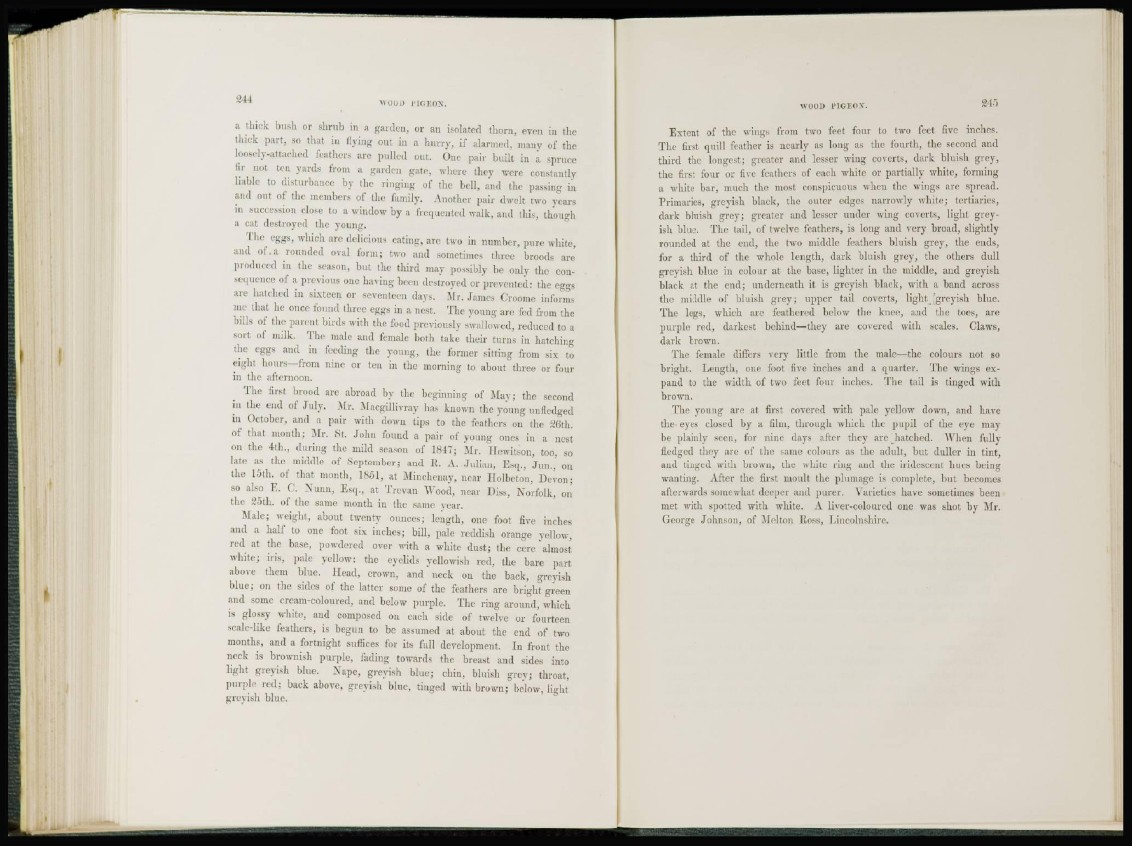
a thick bush or shrub in a garden, or an isolated thorn, even in the
thick part, so that in flying out hi a hurry, if alarmed, many of the
loosely-attached feathers are pulled out. One pair built in a spruce
tit not ten yards from a garden gate, where they were constantly
liable to disturbance by the ringing of the bell, and the passing in
and nut of the members of the family. Another pair dwelt two years
in succession close to a window by a frequented walk, and this, though
a t i t destroyed the young.
The eggs, which arc delicious eating, are two in number, pure white,
and of. a rounded oval form; two and sometimes three broods are
produced in the season, but the third may possibly be only the consequence
of a previous one having been destroyed or prevented: the eggs
are hatched in sixteen or seventeen days. Mr. .lames Croome informs
me that he once found three eggs in a nest. The young are fed from the
bills of the parent birds with the food previously swallowed, reduced to a
sort of milk. The male and female both take their turns in hatching
the eggs and in feeding the young, the former sitting from six to
eight hours—from nine or ten in the morning to about three or four
in the afternoon.
The first brood are abroad by the beginning of Hay; the second
in the end of July. Mr. Macgillivray has known the young unfledged
in October, and a pair with down tips to the feathers on the 26th.
of that month; Mr. St. John found a pair of young ones in a nest
on the 4th., during the mild season of 1847; Mr. Hewitson, too, so
late as the middle of September; and R. A. Julian, Esq., Jim., on
the loth, of that month, 1851, at Minchenay, near Holbeton, Devon;
so abo E. ('. N iinn, Esq., at Trevan AVood, near Diss, Norfolk, on
the 25th. of the same month in the same year.
Male; weight, about twenty ounces; length, one foot five inches
and a half to one foot six inches; bill, pale reddish orange yellow,
red at the base, powdered over with a white dust; the cere almost
white; iris, pale yellow: the eyelids yellowish red, the bare part
above them blue. I lead, crown, and neck on the back, greyish
blue; on the sides of the latter some of the feathers are bright green
and some cream-coloured, and below purple. The ring around, which
is glossy white, and composed on each side of twelve or fourteen
scale-like feathers, is begun to be assumed at about the end of two
months, and a fortnight suffices for its full development. In front the
neck is brownish purple, fading towards the breast and sides into
light greyish blue. Nape, greyish blue; chin, bluish grey; throat,
purple red; back above, greyish blue, tinged with brown; below, light
greyish blue.
Extent of the wings from two feet four to two feet five inches.
The first quill feather is nearly as long as the fourth, the second and
third the longest; greater and lesser wing coverts, dark bluish grey,
the first four or five feathers of each white or partially white, forming
a white bar, much the most conspicuous when the wings are spread.
Primaries, greyish black, the outer edges narrowly white; tertiaries,
dark bluish grey; greater and lesser under wing coverts, light greyish
blue. The tail, of twelve feathers, is long and very broad, slightly
rounded at the end, the two middle feathers bluish grey, the ends,
for a third of the whole length, dark bluish grey, the others dull
greyish blue in colour at the base, lighter in the middle, and greyish
black at the end; underneath it is greyish black, with a band across
the middle of bluish grey; upper tail coverts, light 'greyish blue.
The legs, which are feathered below the knee, and the toes, are
purple red, darkest behind—they are covered with scales. Claws,
dark brown.
The female differs very little from the male—the colours not so
bright. Length, one foot five inches and a quarter. The wings expand
to the width of two feet four inches. The tad is tinged with
brown.
The young are at first covered with pale yellow down, and have
the eyes closed by a film, through which the pupil of the eye may
be plainly seen, for nine days after they are hatched. When fully
fledged they are of the same colours as the adult, but duller in tint,
and tinged with brown, the white ring and the iridescent hues being
wanting. After the first moult the plumage is complete, but becomes
afterwards somewhat deeper and rjurer. Varieties have sometimes been
met with spotted with white. A liver-coloured one was shot by Mr.
George Johnson, of Melton Ross, Lincolnshire.